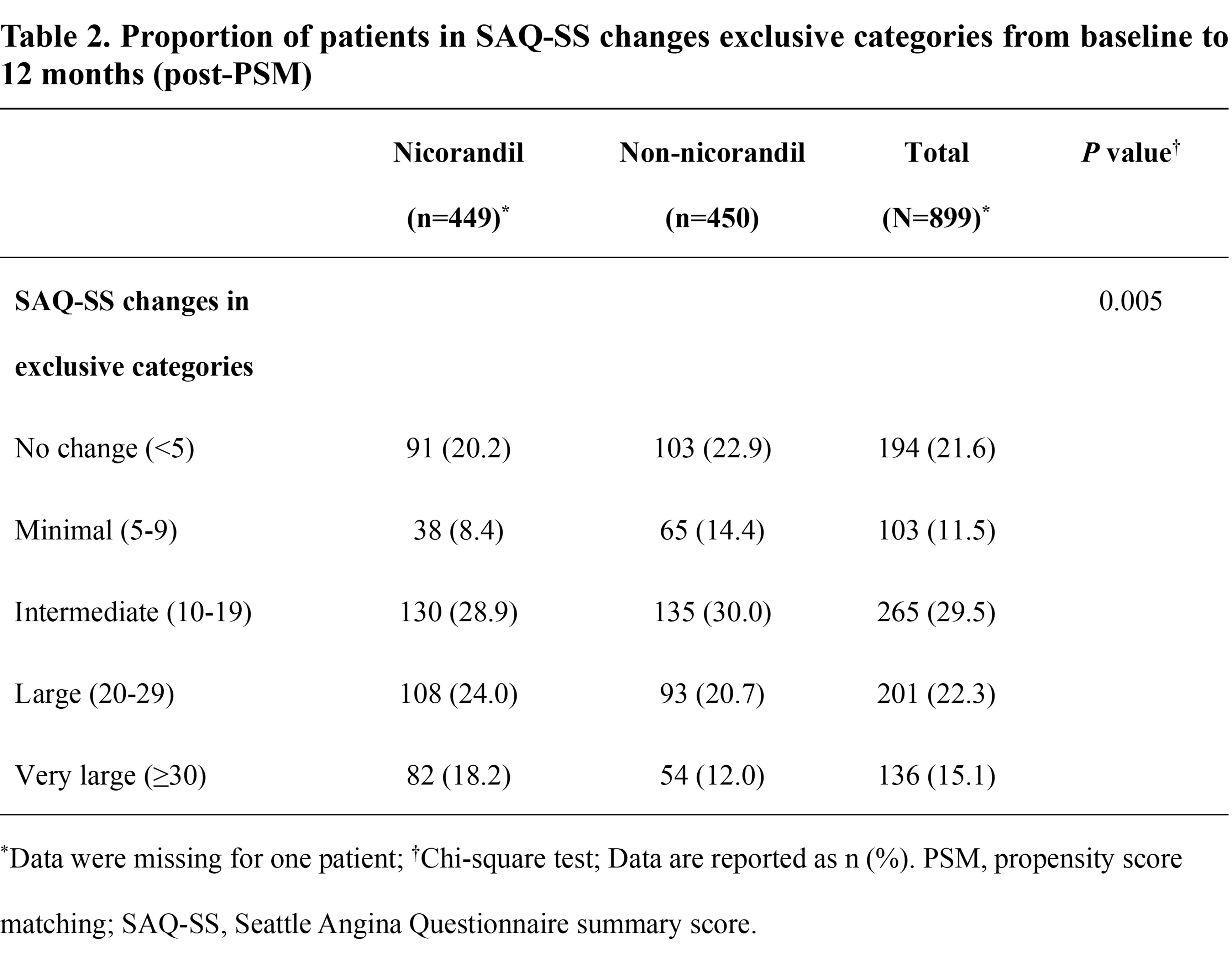Final ID: P2135
Nicorandil improves health status outcomes in patients with angina pectoris: a prospective, multicenter, cohort study (GREAT)
Abstract Body: Background: Coronary artery disease (CAD) is a major contributor to cardiovascular mortality, with angina pectoris affecting nearly half of CAD patients. The GREAT study aims to establish a large cohort of Chinese patients with angina pectoris, evaluating the effectiveness of anti-anginal treatments through the Seattle Angina Questionnaire (SAQ).
Methods: This multicenter, prospective cohort study included 1556 adult CAD patients with angina pectoris receiving or eligible for oral anti-anginal therapy. Patients were observed over 12 months. All participants were registered on an ePRO system via a WeChat Mini program, allowing them to submit questionnaires and clinic visit data. The primary outcome was the 12-month change in the SAQ summary score (SAQ-SS) from baseline. Secondary outcomes included changes in SAQ-SS at 3, 6, and 9 months. Patients were categorized into two groups: those treated with nicorandil (nicorandil group) and those not receiving it (non-nicorandil group). Propensity score matching (PSM) was used to reduce bias and control for confounding factors.
Results: A total of 1528 patients were analyzed (FAS), of which 529 (34.6%) were in the nicorandil group and 999 (65.4%) in the non-nicorandil group. Following PSM, 450 matched pairs were identified. Baseline characteristics were well-balanced. The median age was 60 years in the nicorandil group and 61 years in the non-nicorandil group, and most patients were male (74.2% and 73.3%, respectively). β-blockers were widely used (68.7% and 70.2%, respectively). Both groups showed improvements in mean SAQ-SS across all follow-up points, but the nicorandil group had significantly greater improvements (P<0.05). At 12 months, the nicorandil group had a mean SAQ-SS improvement of 17.6 points, compared to 15.1 points in the non-nicorandil group (P=0.003). Furthermore, nicorandil users had significantly greater improvements in the SAQ quality-of-life (18.9 vs 16.3; P=0.042) and physical limitation (11.7 vs 8.4; P=0.001) domains (Table 1).
In terms of clinical benefit, a higher proportion of patients in the nicorandil group experienced large or very large improvements in SAQ-SS at 12 months (24.0% vs 20.7% for 20–29 points; 18.2% vs 12.0% for ≥30 points; P=0.005) (Table 2).
Conclusion: This real-world evidence demonstrates that nicorandil-based regimens lead to superior health status improvements in patients with angina pectoris compared to non-nicorandil treatments.
Methods: This multicenter, prospective cohort study included 1556 adult CAD patients with angina pectoris receiving or eligible for oral anti-anginal therapy. Patients were observed over 12 months. All participants were registered on an ePRO system via a WeChat Mini program, allowing them to submit questionnaires and clinic visit data. The primary outcome was the 12-month change in the SAQ summary score (SAQ-SS) from baseline. Secondary outcomes included changes in SAQ-SS at 3, 6, and 9 months. Patients were categorized into two groups: those treated with nicorandil (nicorandil group) and those not receiving it (non-nicorandil group). Propensity score matching (PSM) was used to reduce bias and control for confounding factors.
Results: A total of 1528 patients were analyzed (FAS), of which 529 (34.6%) were in the nicorandil group and 999 (65.4%) in the non-nicorandil group. Following PSM, 450 matched pairs were identified. Baseline characteristics were well-balanced. The median age was 60 years in the nicorandil group and 61 years in the non-nicorandil group, and most patients were male (74.2% and 73.3%, respectively). β-blockers were widely used (68.7% and 70.2%, respectively). Both groups showed improvements in mean SAQ-SS across all follow-up points, but the nicorandil group had significantly greater improvements (P<0.05). At 12 months, the nicorandil group had a mean SAQ-SS improvement of 17.6 points, compared to 15.1 points in the non-nicorandil group (P=0.003). Furthermore, nicorandil users had significantly greater improvements in the SAQ quality-of-life (18.9 vs 16.3; P=0.042) and physical limitation (11.7 vs 8.4; P=0.001) domains (Table 1).
In terms of clinical benefit, a higher proportion of patients in the nicorandil group experienced large or very large improvements in SAQ-SS at 12 months (24.0% vs 20.7% for 20–29 points; 18.2% vs 12.0% for ≥30 points; P=0.005) (Table 2).
Conclusion: This real-world evidence demonstrates that nicorandil-based regimens lead to superior health status improvements in patients with angina pectoris compared to non-nicorandil treatments.
More abstracts on this topic:
A new mouse model for the study of cardiogenic TFs Tbx5, Gata4, and Mef2c during cardiogenesis
Leonard Riley, Sweat Mason, Eliason Steve, Zimmerman Kathy, Zhao Yi, Li Xiao, Hatcher Cathy, Weiss Robert, Amendt Brad
Enhanced Vascularization in hPSC-derived Cardiac Organoids by Dynamic CultureHuerta Gomez Angello, Kang Soo-yeon, El-mokahal Marcel, Lee Moo-yeal, Yang Huaxiao


